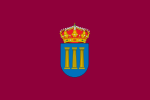Augustobriga
| Ciudad Rodrigo | |||
|---|---|---|---|
| municipality | |||
|
|||
 Location in Salamanca |
|||
| Location in Spain | |||
| Coordinates: 40°35′49″N 6°32′21″W / 40.59694°N 6.53917°WCoordinates: 40°35′49″N 6°32′21″W / 40.59694°N 6.53917°W | |||
| Country | Spain | ||
| Autonomous community | Castile and León | ||
| Province | Salamanca | ||
| Comarca | Comarca of Ciudad Rodrigo | ||
| Government | |||
| • Mayor | Juan Tomás Muñoz Garzón (Spanish Socialist Workers' Party) | ||
| Area | |||
| • Total | 240 km2 (90 sq mi) | ||
| Elevation | 658 m (2,159 ft) | ||
| Population (2016) | |||
| • Total | 12,896 | ||
| • Density | 54/km2 (140/sq mi) | ||
| Time zone | CET (UTC+1) | ||
| • Summer (DST) | CEST (UTC+2) | ||
| Postal code | 37500 | ||
| Website | |||
Ciudad Rodrigo (Spanish pronunciation: [θi̯uˈðað roˈðɾiɣo]) is a small cathedral city in the province of Salamanca, in western Spain, with a population in 2016 of 12,896. It is also the seat of a judicial district.
The site of Ciudad Rodrigo, perched atop a rocky rise on the right bank of the River Águeda, has been occupied since the Neolithic Age. Known also as Mirobriga by those who wish to associate the city with an ancient Celtic village in the outskirts of the modern city.
A key border fortress, it was the site of a 10-day siege by the Duke of Wellington and its capture from the French opened up the invasion of Spain in 1812.
Ciudad Rodrigo is situated on the right bank of the Águeda river, about 89 km (55 mi) south-west of Salamanca and 25 km (16 mi) away from the Portuguese border.
The autovia A-62 (dual carriageway) link Ciudad Rodrigo with Salamanca, Valladolid and Burgos, and with Portugal.
Ciudad Rodrigo has a Mediterranean climate characterised by hot and dry summers, and cool, damp winters.
Ciudad Rodrigo was originally a Celtic village under the name of Mirobriga. The town was later taken by the Romans during the conquest of Lusitania and named Augustobriga.
In the 12th century, the site was repopulated by King Ferdinand II of León, walling it and re-establishing the old Visigothic diocese of Calabria into the new bishopric as suffragan of the Diocese of Santiago de Compostela; it comprised a big part of the province of Salamanca, and a portion of the province of Cáceres, an act confirmed by Pope Alexander III in 1175. This led to the construction of the city’s cathedral, an architectural hybrid of the Gothic and late Romanesque styles. King Alfonso VIII gave the city of Caliabria to the Diocese of Ciudad Rodrigo in 1191. The first bishop of whom anything certain is known was called Pedro (1165) and one of the most celebrated was the learned jurist Don Diego de Covarruvias y Leyva (1560).
...
Wikipedia



